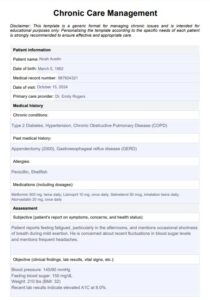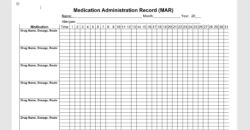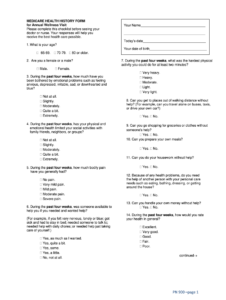Chronic Care Management (CCM) is a vital healthcare service focused on providing structured care for patients with multiple chronic conditions. These patients often require ongoing support, medication management, and coordination of care among various healthcare providers. Accurate and comprehensive documentation is absolutely essential for effective CCM. It not only ensures that patients receive the best possible care but also supports billing and compliance requirements. Without a well-structured system for recording patient interactions, care plans, and progress, it’s easy to lose track of important details, leading to potential errors and reduced quality of care.
That’s where a high-quality documentation chronic care management template comes into play. A good template offers a standardized framework for capturing all the necessary information, from initial patient assessments to ongoing monitoring and adjustments to the care plan. It helps streamline the documentation process, saving valuable time for healthcare professionals and minimizing the risk of overlooking critical details. Think of it as a roadmap for providing excellent CCM services, guiding you through each step of the patient journey and ensuring that everything is properly recorded.
This article explores the key elements of a strong documentation chronic care management template and explains why it’s so important for providing high-quality, compliant chronic care management services. We’ll also delve into the different sections you should include in your template and offer practical tips for using it effectively. By implementing a robust documentation system, you can improve patient outcomes, optimize your billing process, and ensure that your practice is well-equipped to deliver exceptional chronic care management.
Key Elements of an Effective Chronic Care Management Template
An effective chronic care management template isn’t just a form to fill out; it’s a comprehensive tool that supports the entire CCM process. It should guide healthcare providers through each stage of care, from the initial assessment to ongoing monitoring and adjustments. The goal is to create a clear, consistent record of all interactions and interventions, ensuring that everyone involved in the patient’s care is on the same page.
One of the most important elements is a detailed patient assessment section. This should include information about the patient’s medical history, current medications, allergies, and chronic conditions. It’s also crucial to document the patient’s functional status, cognitive abilities, and social support network. A thorough assessment provides a baseline for measuring progress and identifying potential barriers to care.
The care plan is another critical component of the template. This should outline the specific goals of the CCM program, the interventions that will be used to achieve those goals, and the responsibilities of each member of the care team. The care plan should be individualized to meet the patient’s unique needs and preferences, and it should be regularly reviewed and updated as needed. Documenting changes to the care plan, including the rationale behind those changes, is also vital.
Communication is key in chronic care management, so the template should include a section for documenting all patient interactions. This includes phone calls, emails, and in-person visits. For each interaction, record the date, time, duration, the topics discussed, and any actions taken. This provides a valuable record of the ongoing relationship between the care team and the patient.
Finally, the template should include a section for tracking progress towards goals. This can include objective measures, such as blood pressure readings or A1c levels, as well as subjective measures, such as patient reports of pain or fatigue. Regular progress monitoring allows you to identify areas where the patient is struggling and adjust the care plan accordingly. With a reliable documentation chronic care management template, you can significantly improve the efficiency and effectiveness of your CCM program.
How to Use a Documentation Chronic Care Management Template Effectively
Having a well-designed documentation chronic care management template is only half the battle. To truly reap the benefits, you need to use it effectively. This means ensuring that all members of the care team are trained on how to use the template and that it’s integrated seamlessly into your workflow. Consistency and accuracy are paramount when it comes to documentation.
Start by establishing clear guidelines for completing the template. This includes specifying which fields are required, how to format data, and how often the template should be updated. Provide training to all staff members who will be using the template, and offer ongoing support to address any questions or concerns. Make sure everyone understands the importance of accurate and thorough documentation.
Integrate the template into your electronic health record (EHR) system to streamline the documentation process and reduce the risk of errors. Many EHR systems offer customizable templates that can be tailored to meet the specific needs of your CCM program. This allows you to easily access patient information, track progress, and generate reports. If you don’t have an EHR system, consider using a cloud-based document management tool to store and organize your templates.
Regularly review and update the template to ensure that it continues to meet the needs of your practice. As your CCM program evolves, your documentation requirements may change. Stay up-to-date on the latest regulations and best practices, and make adjustments to the template as needed. Seek feedback from your staff and patients to identify areas for improvement.
Finally, use the data captured in the template to improve the quality of your CCM program. Analyze trends in patient outcomes, identify areas where your care team is excelling, and look for opportunities to enhance your services. Effective documentation is not just about compliance; it’s about providing the best possible care to your patients.
By diligently using a comprehensive documentation system, you can significantly improve patient outcomes and ensure that your practice is well-equipped to deliver exceptional chronic care management. Remember, the goal is to create a clear, consistent record of all interactions and interventions, enabling your care team to provide coordinated, patient-centered care.
Ultimately, a well-implemented documentation chronic care management template is an investment in the future of your practice and the health of your patients. It provides a solid foundation for providing high-quality, compliant CCM services, enabling you to make a real difference in the lives of those you serve.



